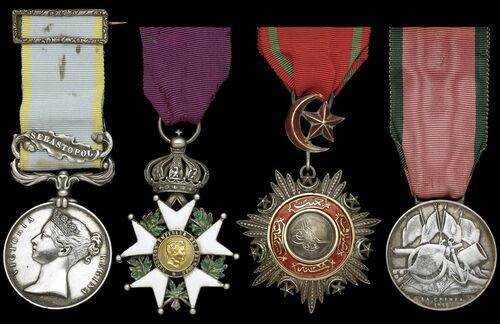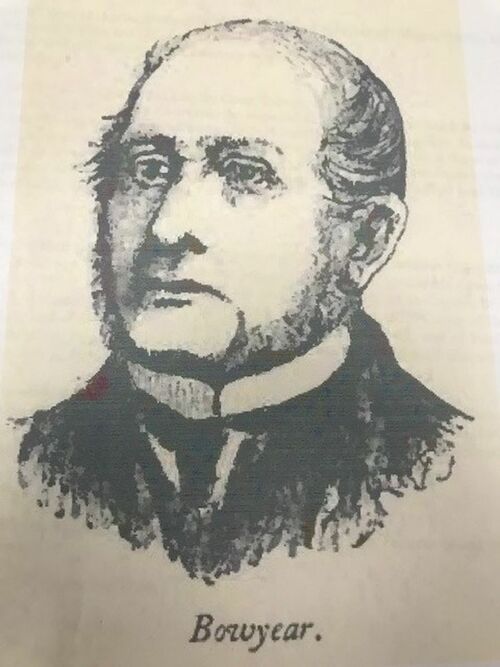Auction: 23003 - Orders, Decorations and Medals
Lot: 145
The campaign group of four awarded to Vice-Admiral G. Le G Bowyear, C.B., Royal Navy
Crimea 1854-56, 1 clasp, Sebastopol (G. L. Bowyear. Commander. Vengeance.), engraved naming, fitted with silver riband bar for wear; France, Legion of Honour, breast Badge, gold, silver and enamel; Turkey, Ottoman Empire, Order of Medjidie, breast Badge, gold, silver and enamel; Turkish Crimea 1855, Sardinian issue, original hole plugged and fitted with outer edge suspension very fine (4)
[C.B.] London Gazette 2 June 1869.
George Le Geyt Bowyear was born at Dilwyn, Herefordshire on 9 September 1815. He was educated privately before joining the Royal Navy on 2 December 1830, being promoted Mate on 24 December 1836. He served aboard Gannet from Christmas Eve 1836-24 February 1838 and thence in Andromache, commanded by Captain Robert Lambert Baynes off the Cape of Good Hope from 25 February 1838-20 November 1839.
Thence a Mate in Winchester, commanded by Captain John Parker, in North America and the West Indies between 21 November 1839-18 April 1840. Made Lieutenant in Racehorse, he was the Commander (2-I-C) in Vengeance, commanded by Captain Lord Edward Russell, in Mediterranean from 1 January 1853-11 May 1855.
An extract from the Life of Vice-Admiral Sir George Tryon, K.C.B. gives more detail:
'While in England the Vengeance changed her commander. Commander Mends was promoted, and Commander George Le Geyt Bowyear took his place. He also is still alive (1897) as a retired Admiral; and on being asked by the present writer for his recollections of the Vengeance and George Tryon, he wrote as follows:
'The Vengeance, 84, Captain Lord Edward Russell, was detached from the Mediterranean station towards the end of 1852, and wintered in England. I joined her at Devonport in January 1853 as commander.... I found a promising set of young fellows in the gunroom. George Tryon was about the senior Mid unpassed, as he certainly was the biggest. I fancy he came to sea rather later than usual, and attained his height early. He was signal officer. The right man in the right place, as I shall soon show. The ship was ready for sea at the end of the spring, and it was intended to send her to Lisbon; but affairs in the East changed everything, and she was ordered off sharp to Malta, to rejoin Admiral Dundas's fleet, and arrived at Valetta early in June, making the tenth line-of-battle ship there. This was an essentially exercising fleet, and the benefit of a good signal officer was immense. George Tryon had a sharp eye and a quick intelligence to put things together.
In harbour Admiral Dundas had a fixed day for exercise, which he always attended himself. The Vengeance had always been about the foremost ship at all evolutions; and the Admiral got furious when the flagship was beaten, and the commander got it hot, and consequently adopted all manner of devices to try and ensure success.'
Admiral Bowyear then describes some of these devices; but the description would scarely be intelligible to any but naval readers, and they will be quite capable of imagining them for themselves without any description, as it is not improbable that they may have seen them practised- in fact, not absolutely impossible that they may have practiced them themselves, or at any rate winked at them, in their own ships.
But all the dodges of the flagship were unavailing, so far as the Vengeance was concerned, for the ever-watchful eye of the signal midshipman and his myrmidons was upon her. And if by night she tried any devices, it was still the same; for if it was too dark to see from his own ship, Tryon used to drop down quietly in the dinghy, or a shore-boat, and lying unsuspected abreast of the erring flagship, his quick eyes and ears would soon detect what preparations she was making for the morrow's drill, and back he would come to the Vengeance and give to his commander such valuable information that the latter was enabled to start on equal terms as the keenly contested exercise of the following morning. No wonder Commander Bowyear appreciated his signal Mid.
In the last chapter we left the Vengeance weighing anchor and preparing to move down towards Sebastopol after the battle of the Alma, which George Tryon had watched from the main-top with his long glass as signal mate, reporting the various phases of it to the deck.
Admiral Bowyear says with regard to this period:
'The duties of the signal officer and his men were most arduous, keeping touch with the armies and witnessing the Alma. Our eyes - as our signalmen were - were at it day and night. Then came the march round, the occupation of Balaklava, the anchorage of the fleet off the Katcha for watering, &c., the bombardment of Sebatopol on the 17th October, the return to the Katcha, the hurricane on the 14th November, the return of many damaged ships to Constantinople, and the battle of Inkerman, when the Vengeance was anchored off Kasatch Bay, and Tryon in the main-top with his long glass reported continually and with great intelligence until the affair was over; after which he joined the Vengeance's Naval Brigade in the trenches.'
Bowyear then served as Commander in Vulcan from 2 October 1855, Captain in Sans Pareil (until paying off at Plymouth), conveying Marines to, and invalids from China between 7 June 1862-11 June 1863. He was Captain in Phaeton (until paying off at Chatham), North America and West Indies between 24 August 1863-24 March 1865, Canopus, receiving ship, Devonport between 20 May 1865-3 September 1865, Revenge, Coast Guard, Pembroke from 2 September 1865, Hector (from commissioning at Portsmouth), Ship of First Reserve, Coast Guard, Southampton Wate 1 May 1868-25 May 1868, Terror, a guard ship based in Bermuda 4 August 1869-13 September 1870 and retired at the end of this posting. The Rear-Admiral died at St.Helier, Jersey on 14 February 1903.
Subject to 20% VAT on Buyer’s Premium. For more information please view Terms and Conditions for Buyers.
Sold for
£1,300
Starting price
£800







